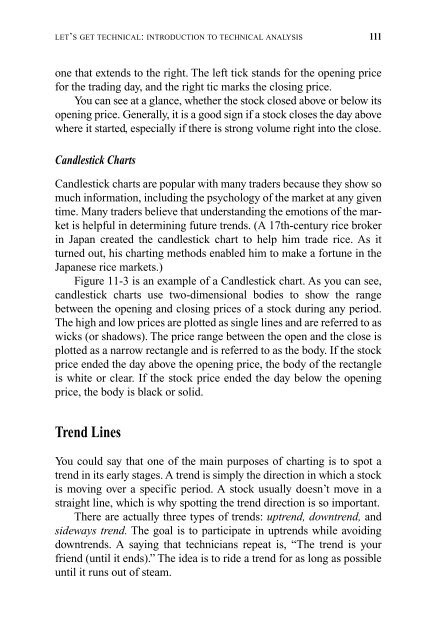Understanding Stocks
Understanding Stocks
Understanding Stocks
You also want an ePaper? Increase the reach of your titles
YUMPU automatically turns print PDFs into web optimized ePapers that Google loves.
LET’S GET TECHNICAL: INTRODUCTION TO TECHNICAL ANALYSIS 111<br />
one that extends to the right. The left tick stands for the opening price<br />
for the trading day, and the right tic marks the closing price.<br />
You can see at a glance, whether the stock closed above or below its<br />
opening price. Generally, it is a good sign if a stock closes the day above<br />
where it started, especially if there is strong volume right into the close.<br />
Candlestick Charts<br />
Candlestick charts are popular with many traders because they show so<br />
much information, including the psychology of the market at any given<br />
time. Many traders believe that understanding the emotions of the market<br />
is helpful in determining future trends. (A 17th-century rice broker<br />
in Japan created the candlestick chart to help him trade rice. As it<br />
turned out, his charting methods enabled him to make a fortune in the<br />
Japanese rice markets.)<br />
Figure 11-3 is an example of a Candlestick chart. As you can see,<br />
candlestick charts use two-dimensional bodies to show the range<br />
between the opening and closing prices of a stock during any period.<br />
The high and low prices are plotted as single lines and are referred to as<br />
wicks (or shadows). The price range between the open and the close is<br />
plotted as a narrow rectangle and is referred to as the body. If the stock<br />
price ended the day above the opening price, the body of the rectangle<br />
is white or clear. If the stock price ended the day below the opening<br />
price, the body is black or solid.<br />
Trend Lines<br />
You could say that one of the main purposes of charting is to spot a<br />
trend in its early stages. A trend is simply the direction in which a stock<br />
is moving over a specific period. A stock usually doesn’t move in a<br />
straight line, which is why spotting the trend direction is so important.<br />
There are actually three types of trends: uptrend, downtrend, and<br />
sideways trend. The goal is to participate in uptrends while avoiding<br />
downtrends. A saying that technicians repeat is, “The trend is your<br />
friend (until it ends).” The idea is to ride a trend for as long as possible<br />
until it runs out of steam.

















